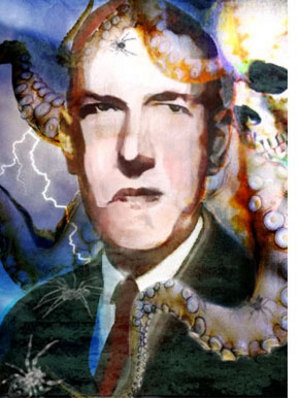In H.P. Lovecraft’s Cthulhu mythos, one of the main fictional characters is of course Cthulhu himself. The deity first appeared in Lovecraft’s story, “The Call of the Cthulhu,” which concerns a dangerous cult that worships Cthulhu as the ‘Great Old One.’
Originally from the Outer Cosmos, Cthulhu is said to presently reside in the sunken city of R’lyeh at the bottom of the Pacific Ocean, sleeping in a tomb there and waiting for the stars to align so He can rise to power once again. Cthulhu’s physical description is quite chilling: A combination of human, dragon, and octopus; his human-shaped body is gargantuan and covered with green reptilian scales, while his head is in the shape of an octopus with numerous undulating tentacles and rubbery feelers around His horrible mouth; claws containing deadly venom adorn his hands and feet while a set of small undeveloped wings protrudes from his broad back.
“That is not dead which can eternal lie,
And with strange aeons even death may die.”
– Abdul Alhazred, the Necronomicon
Why did Lovecraft choose the ocean as the location for the Great Cthulhu to reside and slumber?
In Lovecraft’s youth (and throughout his life, although to a lesser degree) he wrote numerous essays on scientific topics, particularly chemistry and astronomy. For awhile he even stopped writing fiction to devote more time to his amateur nonfiction periodicals, The Rhode Island Journal of Astronomy and The Scientific Gazette. From his studies, Lovecraft must have learned that the Earth’s largest bodies of water contain, and give rise to, the most diverse and fascinating forms of life. This fact surely influenced his description of Cthulhu and also the location in which Lovecraft placed Him after He arrived from the Outer Cosmos.
Every year a multitude of different creatures are discovered in large bodies of water, and occasionally a few are so unique scientists have to invent new names for them. In 2005 a new crustacean was discovered in the Southeast Pacific whose physical appearance was so bizarre it could have easily turned up in one of Lovecraft’s stories. Found 7,500 feet below the surface by a diving team led by Robert Vrijenhoek of the Monterey Bay Aquarium Research Institute in California, this new crustacean was discovered living near toxic, deep sea, hydrothermal vents. The creature has the body of a crab or squat lobster with extra long pincers that are covered with sinuous hair-like strands. The crustacean is also entirely white and has been dubbed the “Yeti crab,” (Yeti – the shaggy humanoid also known as the Abominable Snowman, said to live in the Himalayas); but a new Latin family name had to be invented for the creature’s taxonomic classification: Kiwa hirsuta. The first part of the name comes from Polynesian mythology in which the goddess of crustaceans is known as Kiwa; and the second part from the word ‘hirsute,’ meaning ‘covered with hair’ due to the unusual fibers spanning the length of the creature’s claws.
Could the Great Cthulhu himself have played a part in the creation of this new hairy lobster? Perhaps He was the one responsible for the blonde strands that cover the Yeti crab’s pincers – Lovecraft would have probably liked for us to believe so. It is said he enjoyed attempting to make his fictional stories seem as factual as possible. (For many years I believed the Necronomicon was a genuine historical document.)
But getting back to the new crustacean, what is the exact function of the Yeti crab’s strange hair-like fibers? There are presently two theories. One is that the fibers contain a large amount of bacteria, which helps to detoxify the harmful chemicals oozing out of the hydrothermal vents that the animal flocks toward. Another is that the crustacean feeds off the bacteria collected in the strands. But the Yeti crab does not restrict itself to eating bacteria alone. It has been seen fighting over shrimp, hence making it a carnivore. Scientists are curious to investigate the hair-like fibers further and determine the exact nature of each organism living among them.
One more thing. The newly discovered crustacean is also blind. It has only undeveloped membraneous tissue where its eyes should be. But since it lives at the bottom of the Pacific Ocean, it’s constantly encased in darkness and doesn’t even need eye sight, which takes us back to Lovecraft. Blindness is a characteristic shared by at least two major deities in Lovecraft’s mythos (Eidolon of the Blind, another name for The Dweller in the Gulf – a massive tortoise with no eyes that lives beneath the surface of Mars; and The Blind Idiot God, another name for Azathoth – one of the most powerful Outer Gods).
As you may have already guessed, when I read the article reporting the discovery of the Yeti crab, with its long pincers covered with thick white hair and thin membranes where its eyes should be and its collection of bacteria that destroys toxic chemicals pouring from hydrothermal vents, I was immediately reminded of the supernatural deities in Lovecraft’s mythos; and since I have long desired to add a deity of my own to that distinguished corpus, I immediately sat down and plotted out a story titled “God’s Blood,” in which elements of the Yeti crab would appear.
Allow me to digress for a moment and explain the plot of my story.
Every day a young girl travels over a bridge into town to perform errands for her mother. Upon reaching the end of the bridge, she feels an irresistible force compelling her to leap over the side. The force gets stronger each day until she eventually yields to it. She jumps and lands without injury and the force beckons her toward a cave that she had never noticed before. She enters the cave and travels to the end where she is transported to another planet with undulating red mountains, a seething orange sky, and seven purple suns. A colossal blonde crab-shaped creature, the length of a bus, with no eyes and fur-covered pincers trudges over the sand. His head is an ephemeral mesh of multidimensional polygons and his furry pincers snap with a thousand tiny metallic blades. The creature speaks to the girl in a warbling English telling her his name is Zayv-O-Waith-9, and that he was created by the insane cult that worships Azazoth, which brought him into existence by performing dangerous experiments with the Kabbalah and The Pnakotic Manuscripts.
Zayv-O-Waith-9 continues his bizarre monologue, saying he needs a human to join his body so he can continue his existence and gain more brain power to complete a mathematical theorem that will prove the precise year in which the universe will end. If he succeeds in constructing a rigorous proof, he will use it to convince the Outer Gods to take action and prevent the end of the world from happening. The girl understands and begins to panic. Then she feels her forehead being branded, but sees no branding tool. The pain is tremendous and she screams and begins to lose consciousness. Zayv-O-Waith-9 tells her that without the ancient symbol she cannot join his body. The girl finds herself floating toward Zayv-O-Waith-9 to join him. When she gets closer, another human rises from the creature’s back encased in a thick column of flesh and white fibers, the same hair covering Zayv-O-Waith-9’s pincers. It is the human the girl will replace.
The hair protects you from the influx of evil that exists inside me and as a natural part of the universe,” Zayv-O-Waith-9 says. “Everyone on Earth will soon need the fibers. Without it they will perish.”
Another column rises from Zayv-O-Waith-9’s back. The girl floats to it and her legs begin to sink. She stares at the other human, its menacing skeletal face, long gray hair, protruding yellow eyes – it looks thoroughly decrepit. The girl knows when she is installed in the new column the other person will vanish. She sinks deeper and remembers the vial of liquid in her pocket, the bottle her grandmother had given her years before. She called it, “God’s Blood” and the girl realized her grandmother knew of the dangers in the cave. (Deus ex machina, I know.)
The girl throws the liquid over Zayv-O-Waith-9’s body. He releases a bellicose scream and begins to transform. Both columns withdraw and the girl is thrown to the sand. Zayv-O-Waith-9’s body is distorted greatly by the God’s Blood, he shrinks to half his previous size, develops a pair of tattered primitive wings, and flies away.
The girl wakes near the mouth of the cave, groggy and disoriented. She walks home wondering about the ramifications of changing Zayv-O-Waith-9 with the vial of God’s Blood, what effect it will have on the universe. Raising a hand to her forehead, she feels the brand still there, the scarring thick and prominent, at least four inches wide. She knows she’ll never be able to explain what happened to her mother. Never be able to remove the brand, which is an ancient symbol from the Necronomicon.
I have not written the story yet. But that is the plot inspired by Kiwa Hirsuta and the Cthulhu mythos.
I firmly believe that H.P. Lovecraft was greatly influenced by the bizarre new life forms that the oceans and seas produce every year. And I feel that it is at least partly the reason he placed the Great Cthulhu sleeping in a tomb in the Pacific. But let’s pretend the mythos and the deities in it are real for a moment. Perhaps so much new life is produced in large bodies of water every year because Cthulhu is in the Pacific creating it. Maybe his tomb has degenerated so much now that he is able to send his supernatural powers out through cracks and they are pervading the waters and causing mutation of the existing life. Or perhaps he is even able to leave his tomb occasionally to breed with the other creatures. But if he can do that, why haven’t we seen him? Why has he not reclaimed his power?
In His House at R’lyeh Dead Cthulhu waits dreaming,
yet He shall rise and His kingdom shall cover the Earth.”
– Abdul Alhazred, the Necronomicon






